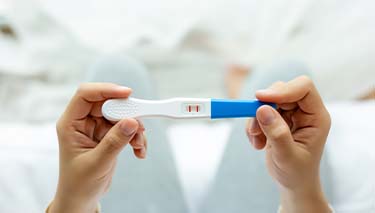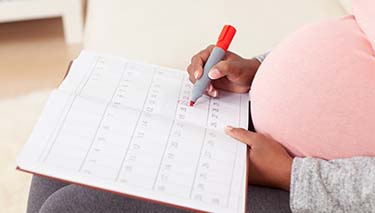For many years, home pregnancy tests have been most women’s first choice to confirm their suspicion they might be pregnant. Home pregnancy tests are inexpensive, disposable kits available over-the-counter from most pharmacies worldwide, some supermarkets also sell them and they can also be purchased online.
Using a home pregnancy test is a great way to choose a time and place where you’re most comfortable, before getting a pretty accurate result on whether or not conception was a success.
What is a home pregnancy test?
Home pregnancy tests are sensitive, once-off test kits that respond to the presence of a hormone called human chorionic gonadotrophin – hCG – in urine. This hormone is released when the fertilised egg first implants in the uterus, usually between 8 and 10 days after fertilisation has occurred (though it can be anywhere from 6-12 days!)
Levels of hCG will rise quickly in the first few days following implantation and peak in the first 8-11 weeks of pregnancy. Within about two weeks, usually when your period is due, the hormone can be easily detected in urine.
Some home pregnancy tests are highly sensitive and can even pick up quite low levels of hCG in urine, giving a response up to a week after implantation.
More sensitive tests can be more costly. Blood tests ordered by a doctor can detect the presence of hCG earlier than urine testing.
The sensitivity of the home pregnancy tests are marked on the box. If you can t wait to find out if you're pregnant, look for labelling which states results may be found before missing a period.
How do I use a home pregnancy test?
Home pregnancy tests come with detailed instructions and information, and for accuracy, follow the instructions carefully.
The test can be done at any time of the day, however testing the first urine you pass in the morning will offer the most accurate result.
Test results can be affected by fertility drugs containing hCG hormones and can also be affected if you have had a lot of fluid to drink shortly before taking the test – as this can dilute the urine. But other medications are unlikely to affect test results.
Home pregnancy tests differ in the way that they need you to collect urine.
For some home pregnancy tests, the plastic stick containing the test strip should be held a few centimetres away from you as you wee directly onto the stick; other tests supply a small plastic container for collecting the urine, which you then put onto the test stick with a dropper.
The way that the test results appear, will depend on the way the manufacturer prepared the kit. Do check the instructions carefully to see what to expect.
In many tests, the response will appear as two lines, parallel or crossed. One ‘control’ result line will
ALWAYS appear; but the second result line will only appear in response to the presence of hCG – so that’s two lines for pregnant, one line for not pregnant.
Some tests reveal a plus or minus sign, or spell the words ‘pregnant’ or ‘not pregnant;’ and some change colour; test results might be red, pink or blue.
Most tests will give a result in five minutes or less. Try to find something to occupy you for that time, as it will seem like an eternity! It can be an excruciating wait.
How accurate are home pregnancy tests?
Most home pregnancy tests are around 99% accurate, provided the instructions are followed accurately. If you have a very irregular cycle, it could be difficult to determine whether the time is right to test.
A false negative result can happen if the testing has been done too early and levels of hCG are too low to detect.
If you get a negative result but you still feel you might be pregnant, wait three days then try another test.
False positives (when the test says you’re pregnant but you’re not) might occur if you have taken a fertility drug which contains hCG or if there is an error in the test.
Many doctors use urine tests that are exactly the same as home pregnancy tests to verify pregnancies. However, if there is some uncertainty about results, your doctor may order a blood test which will also test hCG levels, but is usually more sensitive than a urine test.
Tips for performing a home pregnancy test
- Before you do the test – think about whether you are doing it at the right time and if you would like to have anyone (such as your partner) with you at the time you do the test.
- Most importantly – read the directions carefully, even if you have done a home pregnancy test before. Every brand has slightly different recommendations around their use.
- Try not to do the test too early for two reasons; first, you might get a false negative. And second, because around 10-25% of pregnancies miscarry. Chemical pregnancy can happen when a woman miscarries around the time of the expected period. You may be unfortunate enough to detect a very early pregnancy that doesn’t ‘take’, and experience the emotional journey of miscarriage at a very early stage.
By "Fran Molloy, journalist and mum of four
Last Published* May, 2024
*Please note that the published date may not be the same as the date that the content was created and that information above may have changed since.





















